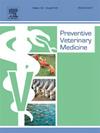Pet treats, Salmonella, and antimicrobial resistance; a One Health problem
IF 2.4
2区 农林科学
Q1 VETERINARY SCIENCES
引用次数: 0
Abstract
Zoonotic pathogens, including Salmonella and antimicrobial resistant bacteria, may contaminate the food or treats consumed by our pets. These may directly impact the health of the pets or may be transferred to humans who are in close contact. To better understand the potential risk, we purchased 505 pet treats from pet and farm supply stores, grocery stores, and online retailers in the U.S. over a period of 16 months to identify and characterize Salmonella and Enterobacterales resistant to Highest Priority Critically Important Antimicrobials. We used selective media to detect Salmonella and bacteria resistant to colistin, carbapenems, fluoroquinolones, and 3rd and 4th generation cephalosporins. Four pig ear treats from Brazil were positive for Salmonella, with serotypes, Muenchen, Derby, Agona and Regent. We found that S. Muenchen and S. Derby were closely related to clinical and environmental isolates from the U.S., Canada, Venezuela, and Colombia. We detected three colistin resistant isolates, Klebsiella pneumoniae, Escherichia coli, and Enterobacter hormaechei, all from pig ear treats from Brazil, harboring the mcr-1.18 resistance gene on identical IncX4 plasmids. In addition, we recovered one carbapenem resistant E. coli harboring both blaKPC-2 and blaNDM-5 from a “bully stick”. We found that treats originating from North America and treats purchased in grocery stores had a lower risk of contamination with bacteria resistant to the antimicrobials tested. Outreach and extension activities are needed to increase awareness of the risks of contaminated pet treats and to highlight the importance of hand hygiene when feeding and interacting with pets.
宠物零食、沙门氏菌和抗菌素耐药性;一个健康问题
人畜共患病原体,包括沙门氏菌和抗微生物细菌,可能会污染我们宠物吃的食物或零食。这些可能直接影响宠物的健康,也可能传染给密切接触的人。为了更好地了解潜在的风险,我们在16个月的时间里从美国的宠物和农场用品商店、杂货店和在线零售商那里购买了505种宠物零食,以鉴定和表征对最高优先级至关重要的抗菌素耐药的沙门氏菌和肠杆菌。我们采用选择性培养基检测沙门氏菌和对粘菌素、碳青霉烯类、氟喹诺酮类和第三代和第四代头孢菌素耐药的细菌。来自巴西的四种猪耳对沙门氏菌呈阳性反应,血清型分别为Muenchen、Derby、Agona和Regent。我们发现S. Muenchen和S. Derby与美国、加拿大、委内瑞拉和哥伦比亚的临床分离株和环境分离株密切相关。我们从巴西的猪耳中检测到三株耐粘菌素的分离株,分别是肺炎克雷伯菌、大肠杆菌和贺氏肠杆菌,它们在相同的IncX4质粒上携带mcr-1.18耐药基因。此外,我们从“霸棒”中回收了一株含有blaKPC-2和blaNDM-5的耐碳青霉烯类大肠杆菌。我们发现,来自北美的零食和在杂货店购买的零食被抗微生物药物耐药细菌污染的风险较低。需要开展外展和推广活动,以提高对受污染宠物零食风险的认识,并强调在喂养和与宠物互动时手部卫生的重要性。
本文章由计算机程序翻译,如有差异,请以英文原文为准。
求助全文
约1分钟内获得全文
求助全文
来源期刊

Preventive veterinary medicine
农林科学-兽医学
CiteScore
5.60
自引率
7.70%
发文量
184
审稿时长
3 months
期刊介绍:
Preventive Veterinary Medicine is one of the leading international resources for scientific reports on animal health programs and preventive veterinary medicine. The journal follows the guidelines for standardizing and strengthening the reporting of biomedical research which are available from the CONSORT, MOOSE, PRISMA, REFLECT, STARD, and STROBE statements. The journal focuses on:
Epidemiology of health events relevant to domestic and wild animals;
Economic impacts of epidemic and endemic animal and zoonotic diseases;
Latest methods and approaches in veterinary epidemiology;
Disease and infection control or eradication measures;
The "One Health" concept and the relationships between veterinary medicine, human health, animal-production systems, and the environment;
Development of new techniques in surveillance systems and diagnosis;
Evaluation and control of diseases in animal populations.
 求助内容:
求助内容: 应助结果提醒方式:
应助结果提醒方式:


